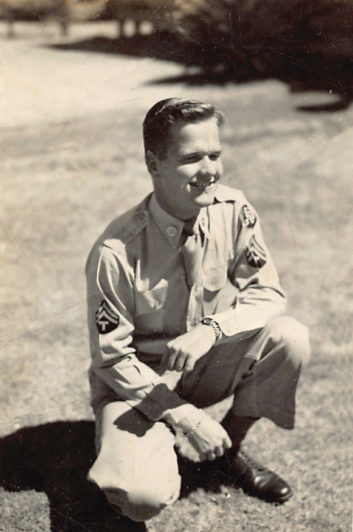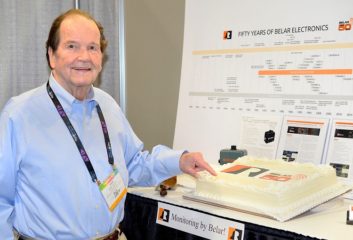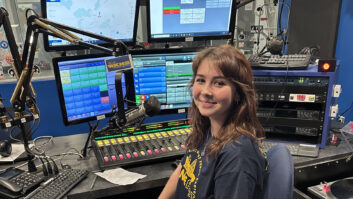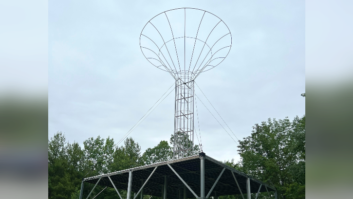
When Arno Meyer passed away in the spring of last year, it marked the end of a notable chapter in radio broadcast engineering.
There’s a good chance that virtually every experienced broadcast engineer, whether working in AM, FM or TV, has used Belar monitors for transmitter testing or proof of performance measurements at some time in their career.
If so, they are the beneficiary of the wisdom, knowledge and kindness of the founder of Belar Electronics Laboratory.
Meyer passed away at age 90 in May of 2019 at his Malvern, Pa., home, following a prolonged illness.
He’d been a member of the Institute of Electrical and Electronic Engineers and the Society of Broadcast Engineers. And while he is best remembered for his long career in broadcast monitoring and RF engineering, Meyer was a skilled woodworker and craftsman of stained glass windows.
ITA
Arno Mark Meyer was born in Munich, Germany, and emigrated to America with his mother when he was less than a year old. He spent his youth in Pittsburgh, where he soon developed an interest in electronics through the repair and construction of radios. He later graduated from Greenbrier Military School in West Virginia.
During the Second World War, he continued to develop his electronics knowledge by enrolling in the Signal Corps. He spent the duration stationed in Hawaii, where he was involved in the testing and development of radar and high-frequency communications systems.
After the war, Meyer lived in California, where he earned an undergraduate degree in physics from the University of California at Santa Barbara. He later moved to Philadelphia and attended classes at the Moore School of Engineering at the University of Pennsylvania, and worked part-time for local electronics companies B&W and Jerrold.
Meyer’s first job after school was at ITA, which was involved at the time in industrial, military, broadcast and shortwave electronics. The first project he worked on was developing a transmitter for NASA’s Project Nimbus, which involved remote sensing of the Earth with satellites.
As he recalled in a Radio World interview, “It involved modifying a 5 kW FM broadcast transmitter to operate at 150 MHz with AM modulation. Eimac had no test data for the transmitter’s 4CX5000 final tube with those parameters, and basically said ‘Let us know how it works out.’” With some careful design and tweaking, the transmitter worked and was accepted by NASA.
Triangle Publishing, a media conglomerate that owned TV Guide and a host of radio and TV stations, eventually purchased ITA, and the company’s focus shifted more towards broadcasting; Meyer’s work projects changed accordingly.
Enter FM
His first assignment was to develop the Documentor, one of the industry’s first program audio logging devices.
Meyer recalled, “It would record 24 hours of audio on a 9-inch disc. Ten years’ worth of these Micro Discs could be stored on a bookshelf five feet long.”
One of the most challenging aspects of the design was creating a ceramic cartridge with a 1 mil stylus. Meyer worked with ITA’s mechanical engineer Buddy Wagner on the project.
By the mid 1950s interest in FM stereo was heating up. Eventually a standard was adopted, and the FCC authorized FM stereo broadcasting on June 1, 1961. Meyer was tasked with designing a stereo generator that could be paired with the ITA FM-10D exciter.
His SG-1D was a 15-tube device that used a fully saturated, balanced bridge modulator to achieve separation greater than 40 dB from 50 to 15,000 kHz, with distortion below 0.25%. This low distortion worked to good advantage with the Serrasoid FM exciters of the day, which themselves had distortion below 0.25% from 100 to 15,000 kHz.
The success of the SG-1D led Meyer to propose to Roger W. Clipp, vice president of Triangle/ITA Electronics, that the company pursue the wide-open market for FM stereo monitors.
Clipp responded that he had no interest in continuing in broadcast electronics, and in fact, wanted to sell the company.
Despite the setback, this was a defining moment for Meyer, as it set the direction for the rest of his career. Soon after his meeting, he handed in his resignation at ITA.
No buyers were found for the firm, and ITA went out of business shortly thereafter.
Isobel+Arno=“Belar”
In 1964, Meyer founded Belar Electronics Laboratory Inc. in the basement of his Drexel Hill, Pa., home.
The name Belar was formed by combining parts of the names of wife and husband Isobel and Arno, thus providing future customers with a great trivia question with which to challenge colleagues at trade shows.
Meyer set to work and released the company’s first product in 1965. The FMD-1 tunable FM detector addressed the need by broadcasters to visualize components of the FM stereo signal.
This device demodulated an FM signal to baseband for display on an oscilloscope or other measurement device. It also functioned as an AM detector to indicate AM noise and synchronous AM noise. The initial price was $89.50.
In fact, the FCC lab used the FMD-1 to verify their measurement of commercial FM broadcast stereo performance standards in the mid-1960s.
Sales of the FMD-1 were brisk, and Meyer used the revenue to fund the design of his first FM monitors, the FMM-1 and FMS-1. Fingers crossed, he sent the working prototypes off to the FCC.
“At that time, all RF monitoring equipment had to have type approval from the FCC before it could be sold to broadcasters,” he later told Radio World.
“I received a call from Larry Miller at the FCC’s Laurel, Md., labs who confirmed that our monitors not only passed the tests but were better than the commission’s own measuring equipment.”
Shortly thereafter, Meyer developed the SCM-1 SCA monitor and RFA-1 FM RF amp to round out the initial FM product line.
Then another stroke of good fortune occurred.
Ramping up
By the time Belar’s FM monitors were approved by the FCC, it had already approved monitors from McMartin Industries and Collins Radio, and a deadline had been set for all FM stereo broadcasters to have type-approved stereo monitors installed.
But Meyer spotted a problem. He did the math and discovered that the FCC’s deadline was, at best, unrealistic.
“We had an attorney present our case to the commission — that two manufacturers could not possibly build enough monitors to meet the deadline, but three manufacturers, with more time, could.”
The FCC concurred, and the deadline was moved back.
Ramping up to meet this demand meant it was time for Belar to move out of Meyer’s basement into real manufacturing facilities, so the company relocated to a plant in Upper Darby, Pa. His first big project in the new space was expanding the company’s product line to include AM and TV monitors.
In the 1970s, interest in an AM stereo broadcasting heated up, and Belar partnered with RCA to develop their standard. The two companies already had a longstanding relationship, since Belar was private-labelling AM and FM monitors for RCA. Using an RCA Ampliphase exciter as a test bed, Meyer developed both the generator and decoder, which was first shown in 1974 at the NAB Show in Chicago.
RCA eventually dropped out of the AM stereo race, but the standard continued as the Belar AM-FM stereo system.
Mark Grant, Belar CEO, said the company has always worked closely with audio processor and transmitter manufacturers. “They use our monitors in the development of new products, and they are always pushing the state of the art forward. Questions would sometimes arise as to whether anomalies were in the monitors or the company prototypes. Arno was always heavily involved in the process because a lot of what he learned was used to advance the capabilities of Belar monitors.”
Meyer was presented with the NAB’s Radio Engineering Achievement award in 2001. Letters of nomination came from Bob Orban, recipient of the 1995 NAB Radio Engineering Achievement Award; Geoff Mendenhall, recipient of the 1999 NAB Radio Engineering Achievement Award; Larry Cervon, former president of Broadcast Electronics; and Steve Hemphill, founder of Solid Electronics Labs.
When asked in 2010 about the secret to his success, Meyer chose one word: “Care. Care in design, care in manufacture, care in testing and care in customer service.”
All about accuracy
Colleagues recalled Meyer not only for his relentless pursuit of excellence in developing products, but also for the generosity of his time and knowledge and the fairness with which he treated customers.
Jeff Keith, senior product development engineer at Wheatstone, recalled an early encounter.
“Around 1975, I was CE of an AM/FM combo in Altoona, Pa. We’d been notified by the FCC that our FM was 3,600 Hz high, while our year-old Belar FMM-1 said we were –220 Hz. Measuring the FM carrier with two other means confirmed that we were indeed about 3,600 Hz high.”
Keith called Belar and was surprised when Meyer answered the phone.
“I explained the situation. His reply was, ‘Give me your shipping address and I’ll send you a new crystal.’ When I asked how much it would cost he said, ‘I’m not going to charge you for the part. The monitor shouldn’t have been lying to you.’”
When Keith began attending the NAB Show in 1980 he looked Meyer up to say hello and thank him for the support five years earlier.
“To my surprise, he actually remembered that incident. Every NAB thereafter, Arno was the very first person I’d go find to say hello.”
Greg Ogonowski, president of StreamS/Modulation Index, LLC, has devoted considerable energy to addressing FM overshoot problems; Belar monitors were one of his key factors for success.
“In the early ’80s, Gregg Laboratories developed a precision overshoot-compensated low-pass filter for AM and FM audio processing, which later became the Orban ‘0’ Card for Optimod-FM. Belar monitors were instrumental in this design because of their accuracy,” he said.

“Shortly thereafter, using Belar monitors in our laboratory, Modulation Index LLC, we discovered some serious peak modulation control issues with many popular studio-to-transmitter links and FM exciters, as well as other monitors, which basically ‘undid’ the precision peak control your expensive audio processor was providing. Modulation Index then developed several modifications for these systems.”
“The accuracy of the Belar monitors helped us achieve all these goals, allowing broadcasters a loud, legal signal, and became a very important part of our arsenal of trusted test instruments. There was never more truth in advertising than their slogan, ‘When Accuracy Counts, Count on Belar.’”
A fascination with problems
Geoff Mendenhall, retired VP of Harris Broadcast and now consulting at Mendenhall Engineering LLC, had a close relationship with Meyer across several decades.
“After graduating from Georgia Tech, I wound up going to work for the Gates Radio Division of Harris Corp., where I became a long-term customer and reseller of Belar equipment,” Mendenhall said.
“Arno was very personable and always willing to help with engineering challenges. We collaborated over a span of many years, constantly improving the design of FM exciters and FM modulation monitors, which had to be matched in measurement capabilities as the state of the art evolved and improved over time.”
Mendenhall and Meyer often lent equipment to each other to verify measurement results, and in the process, Mendenhall said, he learned a lot about designing better and better FM modulators.
“When we needed a composite FM demodulator that was capable of measuring the analog FM signal to noise ratio down to and beyond 100 dB and distortion to less than 0.02%. Only the Belar FMM-2 could reliably do the job,” he continued.
“I remember Arno’s major involvement in the AM stereo initiative with the RCA/Belar AM+FM system, then later in the design of TV/BTS-TV stereo modulation monitors, and more recently, in the design of digital HD Radio modulation monitors. … Arno had a major impact on the technical evolution of FM broadcasting.”
Bob Orban, consultant to Orban Labs, recalls that Meyer was instrumental in helping him to understand FM overshoot issues, and to bring his premiere product to market.
“In 1972 I built a custom stereo limiter that had no low-pass filters and relied on clipping for peak control. Without filtering, the clippers produced a lot of energy above 15 kHz,” Orban said.
“A mystery arose when, with some program material, modulation peaks that were clearly well controlled at the studio produced egregious over modulation on the air as read on the FMM-1. A call to Arno revealed the reason: While removing the above-15 kHz energy produced by the clippers, the 15 kHz low-pass filters in the Collins stereo generator were overshooting and ringing. I took a scope up to the transmitter and, sure enough, Arno was right, that was exactly what was happening.”
With that in mind, Orban next designed non-overshooting low-pass filters and packaged the compressor, limiter, high-frequency limiter, filters and stereo generator together, as a system.
“I proceeded to design and prototype a single channel of this processing and build it on a perf-board. Upon consulting with Eric Small about package design, transmitter interfacing and regulatory requirements, I proceeded to prototype a stereo version of this processing, including built-in stereo generator. I called the result Optimod 8000A.”
Again, Meyer stepped in to help. He offered space in Belar’s 1975 NAB booth to Orban Associates to demonstrate the prototype 8000A, and how well it controlled modulation as indicated on Belar monitors.
“With this demo, Orban was off and running in the broadcast marketplace,” Orban said.
Circuit design consultant Bill Gillman recalled a relationship with Meyer that spanned 40 years. “I met Arno at my first NAB convention, April 1980 in Las Vegas. I was a 21-year-old chief engineer at an AM/FM in Provo, Utah.
“Explaining that I had ran into difficulty completing the required annual proof of performance measurements on my FM, Arno carefully proctored me on the interconnection and grounding of the Belar FM Stereo Monitor and my associated test equipment. His advice delivered a set of excellent measurements. I admired his gentle, quiet and expert manner, a truly competent engineer and business owner,” Gillman said.
“Years later, I held the position of vice president of Engineering at Gentner Communications, a broadcast equipment supplier. The Gentner and Belar NAB convention booths were often in close proximity. When booth traffic was low, Arno and I would get together and compare notes on everything in our respective designs and on everyone we knew at NAB.
“He was generous with his intellect and had a superior dry wit that I both admired and enjoyed. I am better and happier at my craft today because of Arno Meyer.”
Mark Grant recalls his years working with Meyer as the company’s monitors transitioned from analog to DSP devices. “Arno was always contributing, even though he wasn’t a DSP guy. He saw the big picture and was always shooting for better specs. The concepts of broadcast monitoring are the same as always, they’re just done with digital filters and firmware,” Grant said.
“Arno also had a fascination with problems. If you injected a signal into a device and the response wasn’t what you expected, he would pursue it to the very end to find out why. He saw it as a lesson to be learned.”
Grant concludes that the culture that Meyer nurtured at the Belar plant was a testament to his values and leadership.
Perhaps the life and career of Arno Meyer may best be summed up by Steve Hemphill, who said, “Unlike his monitors, Arno’s effect on the broadcast industry was truly unmeasurable.”







